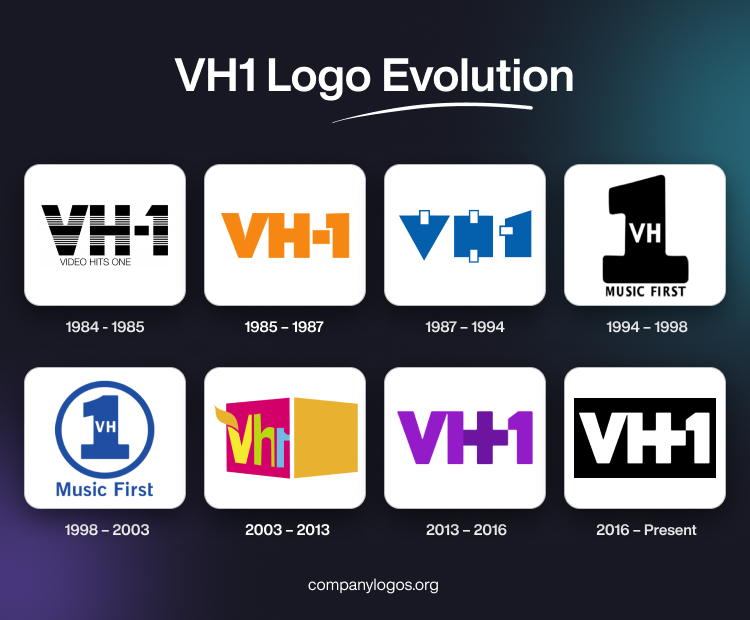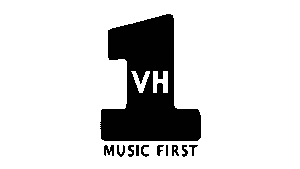
VH1, or Video Hits One, is a US-based TV channel that was launched in 1985 by Warner Amex Satellite Communications in New York City. It was conceived as a variant of MTV to play music only for people over 25 years old. However, with time, the channel changed its content structure to include reality shows and other sundry programmes. Today, it is owned by CBS Entertainment Group and is controlled by BET Networks.
The VH1 logo has undergone several changes since the founding of the channel in 1985. These reflect both shifts in branding strategy and broader changes in music and pop culture television. The article delves into the various logo changes of VH1, among other details.
The Genesis of the VH1 Logo (1984 – 1985)
The original logo of VH1 features the massive wordmark “VH-1” in sans-serif letters with a horizontally striped pattern in black and white. The letters had thick black patterns at the top, middle, and bottom. Beneath it was written the phrase “VIDEO HITS ONE” in a smaller size in black.

(1985 – 1987)
In the first logo change, the full name written below was removed, and the main text “VH-1” was rendered in orange. The right vertical bar of the letter “V” was connected to the letter “H” at the top.

(1987 – 1994)
The 1987 logo iteration introduced more abstract, geometric shapes to spell out “VH1.” This gave the brand a playful and creative energy. The figures included an inverted triangle, a rectangle, and another rectangle with an inclined top bar. There were small white triangles placed on top of the first triangle, both vertical ends of the second rectangle, and the left side of the third rectangle.

(1994 – 1998)
In 1994, VH1 was rebranded with a logo that featured the letters “VH” in a much smaller size in white within a prominent and large “1” in black. Beneath it was the slogan “Music First” in uppercase without serifs. This design emphasised the channel’s commitment to music programming.

(1998 – 2003)
In 1998, the previous logo iteration evolved into a more minimalist look. It adopted a blue colour palette and a circle motif, and the text “Music First” below.

(2003 – 2013)
In 2003, VH1 introduced a bold new era with a box logo. It was a pink square containing the “VH1” initials, often with orange or other vibrant colour accents. This design was described as “funkadelic” and “slightly retro,” with some 3D elements similar to MTV’s branding. There was another square in orange at an angle to the pink square. Together, they created an optical illusion of a box. Further, the pink square had the brand name, where the letter “V” had a protruding orange leaf.

(2013 – 2016)
The next logo design of VH1 came in 2013, wherein it introduced a simplified wordmark “VH-1” in purple. The letter “H” had a distinctive plus sign incorporated into the logo. The plus sign was intended to symbolise VH1’s blend of “music + pop culture + nostalgia.” The new logo was a single-colour typeface and has moved away from the complex, multicoloured designs of the past.

(2016 – Present)
Since 2016, VH1 has used a refined version of the 2013 wordmark in white set against a black rectangular background. The logo is aligned with the vision of VH1 of modernity and progress in the music industry.

The Elements of the VH1 Logo
Font
The wordmark used in the VH1 logo uses a massive, bold sans-serif typeface where the “+” sign is woven into the horizontal bar of the preceding letter “H.”
Colour
The logo employs a black and white colour combination to depict minimalism.
The History of VH1
VH1 was originally known as Video Hits One, and it is an American cable television network that made its debut on January 1, 1985. It was conceived as a sister channel to MTV and was created by Warner-Amex Satellite Entertainment (then a division of Warner Communications) to build on the success of MTV while targeting a slightly older demographic.
The channel initially focused on the lighter, softer side of popular music. It catered to adults with genres like soft rock, smooth jazz, oldies, and adult contemporary. In fact, its early programming featured artists such as Olivia Newton-John, Kenny Rogers, Tina Turner, Elton John, and Fleetwood Mac, as well as Motown and 1960s oldies footage.
VH1 launched in the channel space that was formerly occupied by the short-lived Cable Music Channel. From the outset, it differentiated itself from MTV by appealing to viewers aged 18 to 35 and older. It focused on music videos and VJs (video jockeys) who introduced and discussed music content. In 1985, Warner Communications sold a 31% stake in VH1 and its sibling networks (MTV and Nickelodeon) to Viacom, which acquired full ownership in 1986.
Throughout the 1990s, VH1 expanded its programming with original music-related shows such as Pop-Up Video, VH1 Video Timeline, and the acclaimed documentary series Behind the Music, which became one of its most recognisable franchises. The 2000s marked a significant shift for VH1 as the network began to move away from music videos and embraced pop culture and reality television.
This era saw the rise of the Celebreality programming block, with shows like The Surreal Life and its spinoffs. The success of Flavour of Love saw a move toward reality shows featuring African-American personalities. This led to popular series like Basketball Wives and Black Ink Crew.
In the 2010s and 2020s, VH1 further developed franchises such as Love & Hip Hop, which became its longest-running programme. By this time, music programming had largely disappeared from the schedule and was replaced by reality and celebrity-focused content. Between 2022 and 2025, VH1 temporarily moved to the BET Media Group but returned to the MTV Entertainment Group in 2025. On April 22, 2024, VH1 ended its analogue TV service and continued as a digital-only channel.
VH1 is best known for its influential music documentaries, nostalgia-driven series like I Love the…, and its role in shaping reality television centred on celebrity culture. Internationally, a UK and Ireland version of VH1 was launched in 1994, reflecting the American channel’s focus on adult contemporary music.
However, later, it changed to general entertainment, though the UK channel ceased broadcasting in January 2020. Thus, the evolution of VH1 from a music video channel for adults to a pop culture and reality TV powerhouse reflects broader shifts in American television and viewer preferences over the past four decades.
Interesting Facts About VH1
- VH1 was originally launched to appeal to an older audience than MTV. It focused on softer music genres and adult contemporary hits, which set it apart from its edgier sister channel (MTV).
- Flavour of Love became one of the most iconic reality shows on VH1. It featured rapper Flavour Flav and spawned memorable moments like the infamous “spit” incident and breakout star Tiffany “New York” Pollard. This show led to several spin-offs, including I Love New York and Charm School.
- VH1 is known for creating the “Celebreality” genre, with shows like “The Surreal Life.” The show brought together unlikely groups of celebrities to live under one roof, thereby resulting in unpredictable drama and viral moments.
- RuPaul’s Drag Race, which moved to VH1 in 2017, became one of the network’s biggest hits. It helped to bring drag culture into mainstream pop culture and won multiple Emmy Awards.
- Behind the Music and Pop-Up Video on VH1 were groundbreaking music documentaries and trivia shows. They blend storytelling and entertainment and are still fondly remembered by fans.
- VH1’s “I Love the…” series (such as I Love the ‘80s) became a pop culture phenomenon. Here comedians and celebrities humorously reminisce about trends, music, and fads from past decades.
- The network has been home to several long-running franchises, which include Love & Hip Hop and Basketball Wives. The two shows generated numerous spin-offs and consistently high ratings.
- VH1 has featured unique documentary series like Metal Evolution, which explored the history and subgenres of heavy metal music. The series appealed to passionate fan communities.
- At its peak, VH1 was a launchpad for reality TV personalities, many of whom became celebrities in their own right. The names include Tiffany “New York” Pollard and the cast members of Mob Wives and Black Ink Crew.
- VH1’s programming has covered a wide range of topics. These include celebrity family therapy (Couples Therapy), dating experiments (Dating Naked), and even culinary entertainment (Martha & Snoop’s Potluck Dinner Party).
Finally
Over the years, the VH1 logo has reflected the evolving identity of the channel. It represented the transition of the channel from a music video hub for adults to a pop culture and reality TV powerhouse. In doing so, the logo adapted to design trends and audience expectations.